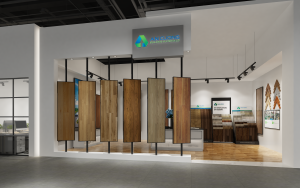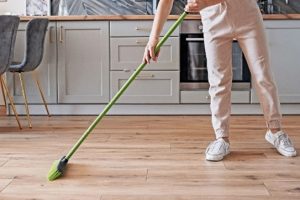Resilient flooring in total has been the industry growth leader for the past two decades charting a meteoric rise and capturing the second largest piece of the floor covering pie in 2023 — LVT alone accounts for 27.6 percent of manufacturers’ sales. Still, the category has been challenged as market sales values have dropped across categories from 2022 to 2023.
Reflecting on Renormalization
According to Catalina Research, in 2023, dollar flooring sales in LVT declined by 7.2 percent while vinyl sheet was down 12.4 percent and other resilient was down 18.3 percent. Several market factors contributed to the decline.
Offered Mohawk’s Adam Ward, vice president of resilient, “There was a lot of inflation that came in 2022 due to lockdowns, demand, supply chain challenges — you name it. We were reporting price increases every other month. We were seeing this in other industries too; [for example] car prices are starting to come back down. The main factor there is inflation working itself out as the market normalizes.”
Ward noted that existing home sales were the lowest they’ve been in a long time as well, which is a “big dropper of our industry and the remodel industry.” He added, “New home sales remain strong as people are spending their money on travel and experiences, as they already spent on their houses during COVID. High interest rates were a big factor in that [drop] as well, however you’re seeing that normalize now.”
Yon Hinkle, vice president of product management, resilient, AHF Products agreed, noting there was a hangover effect from COVID in which there was a dramatic lift in spending that would be qualified as abnormal. “People were in their houses spending money on fixing things up. There was also an influx of cash and a lot of that was spent, so there was an unnatural lift. People were spending elsewhere like on travel.” However, he said the category is still very healthy and is seeing a lot of overall growth.
And with interest rates also still high, fewer people are incentivized to buy a new house, leading to fewer full-home flooring renovations, noted CALI CEO, Doug Jackson. Instead, homeowners are reflooring one or two rooms at a time, resulting in smaller projects.
According to Thomas Baert, president & co-founder of CFL, a significant factor influencing the category has been the normalization of shipping as well as material costs following years of disruption due to the COVID-19 pandemic.
“During the pandemic, both surged dramatically due to supply chain disruptions and increased demand. As these conditions stabilized, they began to normalize, leading to a reduction in overall pricing pressure. However, it’s important to note that shipping costs have once again reached high levels. This renewed increase in shipping costs is likely to result in higher market prices for resilient flooring products,” he said.
Everyone has been affected by supply chain issues, noted Jackson. “But manufacturers who import from China have also dealt with the enforcement of stricter environmental and labor standards, increasing production costs and making vinyl less competitive.” He explained the cost of raw materials for producing vinyl flooring has increased due to supply chain disruptions and greater demand in other industries. “This has led to higher prices for vinyl flooring, making it less attractive to price-sensitive customers,” said Jackson. At the same time, he added, the industry faced higher transportation costs and other inflationary pressures, further driving up prices.

Diversifying Supply
Because of the supply issues surrounding imports from China, in 2023 many suppliers had shifted to importing from other countries like Taiwan and Cambodia, for example. They have also enhanced their products’ features and visuals.
“MSI has always had a highly diversified international network of factories beyond China, Mexico and Thailand, and we continue to maintain a highly diversified production base that insures us against any disruptions. We have expanded our LVT portfolio to include higher-end products such as our Laurel and Laurel Reserve series that offer new high-definition graphics,” said Sam Kim, MSI senior vice president.
AHF’s domestic manufacturing footprint has allowed the company to weather the storm, said Hinkle. “While we do source, we have more options here than anyone and we’re able to utilize that to give confidence to our customers that they will have product when they need it. We have customers now coming to us because of what’s happening with the supply chain yet again. That unpredictability has become hard to ignore and they want supply they can rely on at a cost they were quoted. We are heavily weighted towards domestic production.”
Engineered Floors has invested in its domestic manufacturing footprint with its DLVT plant coming online earlier this year. The company predicts supply chain issues will be a continued problem, offered Joe Young, vice president of residential product and marketing. “While it is difficult to predict what the next problem will be, droughts in Panama, global wars in the Middle East., etc. it is safe to assume the global supply chain will continue to be a problem with disruptions. Our U.S. made product is getting a great response as customers have grown weary of all the supply chain issues.”
At CALI, Jackson noted the company owes a lot to its product development team who has navigated supply chain challenges to free CALI from a reliance on Chinese imports. “Their expertise has given us a significant advantage, which we’re happy to pass onto our partners and customers,” he said.
LVT Lives Large
LVT’s square foot sales were second highest to carpet and area rugs in 2023 with the product seeing continued demand. And industry experts say the category still has growth opportunity.
Advised Travis Cramer, senior director of product management, Tarkett Home, “LVT, with its waterproof and family and pet friendly features, continues to attract consumers seeking functionality and style. Meanwhile, technology advancements in SPC and WPC have allowed for deeper embossing and pressed bevels, contributing to more realistic visuals. We’ve seen this evolution in design and technology broaden the appeal for these options.”
Agreed David Sheehan, senior vice president of residential product and marketing, Mannington, “LVT continues to be driving the most value to the consumer and it has earned its rightful place as the dominant flooring category in North America. Superior realistic visuals, waterproof construction and ease of installation are among the reasons why retail sales associates are directing consumers to LVT.”
LVT has taken significant share from other resilient flooring like vinyl composite tile and sheet vinyl due to its unmatched features and benefits.
“Sheet is a very cost competitive product, but we believe most consumers today are willing to pay additional for the planks in rigid flooring versus full spread VCT and sheet vinyl. Those products will always play into commercial settings and should follow those segment trends, specifically in hospitality and healthcare,” remarked Shaw’s Rod MacLeod, director, resilient category.
However, SPC is still the majority of sales even with setbacks. Noted Jamann Stepp, senior vice president of hard surface at Stanton, “That category is about 50 plus percent and LVT is at a close second, probably covering around 20 percent of the market. Sheet vinyl comprises a very small percentage, probably less than 10 percent and flexible LVT, glue down and WPC are pretty close in their volume uses — combined, about 25 percent to 30 percent. I think the dynamics are going to continue. I don’t see sheet garnering any strength of double-digit ownership in the category,” he said.
Focusing on the Future
Despite high interest rates, suppliers are bullish for steady growth following the market downturn and see the category continuing to capture consumer dollars.
“We believe the category will observe modest growth in 2024. Currently, the market is slow driven by higher interest rates, a sluggish housing market and a remodel business that has yet to recover from the pull forward demand caused by the pandemic,” noted Mannington’s Sheehan.
Agreed, Cramer at Tarkett Home, “With the same challenges of high interest rates and inflation impacting discretionary spending, impacting the market, we believe that we will remain soft until Q4, particularly retail with residential replacement. We are modestly optimistic that the market could start to bounce back in 2025. Higher- end goods and the multi-family market should continue to see strong activity.”
Mohawk’s Ward views the reset in pricing as more of a course correction over the long term. “We’ve had a lot of inflation come in and we’ve seen it come out. Underlying demand for the product is still there. When you look at what people want, they want a hard surface. It’s still a high-performing product and the biggest category in the U.S. — all those factors are going to continue to drive demand for rigid core. Even with the decline, we still became the number one category overtaking carpet last year,” he said.
Many suppliers believe the industry has hit bottom, making room for a solid rebuilding of the flooring market once interest rates begin to come back down.
“The lots of pent-up demand and should contribute to the next three to five-year growth cycle for both flooring and the macro domestic economy,” offered MacLeod, at Shaw.









